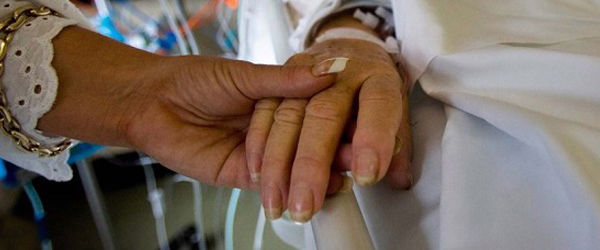Wendy Barnes knew her pimp — the father of her three children, the man who had lured her into prostitution at the age of 15 — was going to beat her. And she knew she just couldn’t take it anymore. “I had to get out of that life,” said Barnes. “I had to get away from me.”
So she ran. She’d gone about a block before she realized it was snowing. Another block flashed by, and she realized she didn’t have any shoes on.
But it wasn’t until she found a hiding place behind a dumpster that the biggest realization hit her: “I knew,” she said slowly, “no one cared.”
Barnes was eventually arrested admitted and spent two years in jail — a turning point. “It was my escape from him,” she told a stunned audience of more than 200 attending “Human Trafficking: The Child Slave,” a March 10 symposium at Mount St. Mary’s College’s Doheny Campus. The event was sponsored by the Southern California Partners for Global Justice, a group made up of more than a dozen religious orders, the Coalition to Abolish Slavery and Trafficking, and the Archdiocese’s Office of Justice and Peace.
Human trafficking is the recruitment, smuggling, abduction, transportation, harboring, buying or selling of a person by means of force, fraud, threats or coercion for commercial and sexual exploitation. It does not have to involve transporting people over international boundaries or state lines; U.S. citizens can be trafficked within the United States. Barnes grew up in Oregon, for instance.
“One hundred and seventy-three countries have laws against selling people,” keynote speaker Sandie Morgan told a full auditorium.
“It’s like, ‘Why do we need a law?’” she continued. “Because if there’s a law, there are consequences, and we live in a culture where people obey the law because of consequences.”
However, added Morgan, the former administrator of the Orange County Human Trafficking Task Force, just because one doesn’t buy or sell another human being does not mean that one is not implicated in the morass of human trafficking.
“Our culpability in driving demand for human trafficking isn’t just the people purchasing children for sex,” said Morgan flatly. “It’s as simple as slave labor on your grocery store shelf.”
Among the exhibitors at the symposium was Catholic Relief Services, helping attendees understand how fair trade products provide laborers with a fair wage, allowing them to support their families with dignity; fair trade is an alternative to labor bondage, which is one facet of human trafficking.
Sex trafficking is another facet — the one that impacted Barnes. Another speaker, Papito Ojok, is a native of Uganda, where many of his peers were abducted and coerced into becoming child soldiers in a war that started long before they were born. (Joseph Kony, the leader of the Lord’s Resistance Army, is the man behind the child soldiers, and the subject of the “Kony 2012” awareness campaign that, coincidentally, went viral the week before the symposium.)
Though Ojok escaped that fate, his family was decimated by the war. Rebels came to his home and killed his father; his aunt was raped, then murdered; his sister was abducted, and to this day he does not know what became of her.
“I was very young — age of 7 — when I started to live on my own,” said Ojok in an interview. But networking and quick thinking helped him as he struggled in a displaced persons camp, anxious to attend school and stay out of rebel hands.
When he encountered Invisible Children — the organization behind “Kony 2012” — he was accepted into their scholarship program. This fall he will begin law school, with an eye toward practicing international law to try to help protect children around the world whose vulnerability puts them at risk.
Survivors’ stories and current statistics painted a stark portrait of the pervasiveness of human trafficking in all parts of the world — but that is what attendees came to hear.
“It’s important to hear what strategies exist that we can help our community know how to deal with [human trafficking] in a better way,” explained attendee Marge Driscoll, a member of the Justice and Peace Council at St. Mel in Woodland Hills.
The issue is massive, but every effort helps. Certainly “Kony 2012” has turned up the volume on the conversation about human trafficking and human dignity. In Los Angeles, the Sisters of St. Joseph of Carondelet demonstrate on Sunset Boulevard with anti-trafficking signs the first Friday of every month. In the fall, a major motion picture — “Trade of Innocents,” starring Mira Sorvino and Dermot Mulroney — will be released in theaters, showcasing the sex tourism trade.
Simply attending events like this one is a big step, Barnes told the audience — not only because attendees become informed and empowered, but because they give hope to survivors. Recalling that snowy day when she hid behind the dumpster and knew she was alone, she can see how far she’s come — and how awareness of human trafficking has grown.
“I can look out there today,” she said, “and know there are people who care.”
BOX
Watch out: Signs that someone’s been trafficked
Take a second look if you see someone:
---accompanied by a controlling person or boss;
---lacking control over schedule, money, identification and travel documents;
---who is transported to or from work;
---who lives and works in the same place;
---with debt owed to employer or crew leader, or unable to leave a job;
---bruised, depressed, fearful, overly submissive.
To report suspected trafficking, call the National Resource Center: 888-373-7888.
{gallery width=100 height=100}gallery/2012/0323/trafficking/{/gallery}

